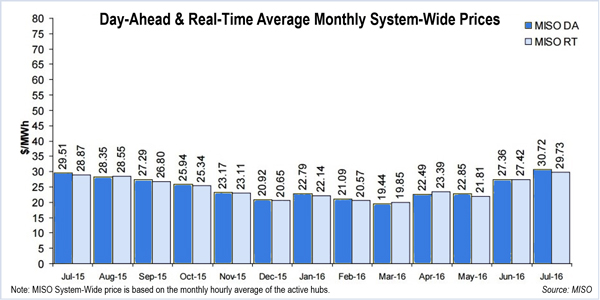MISO’s average load during July was 87.9 GW, 4.8 GW more than June and about the same as last year, said Shawn McFarlane, executive director of strategy and enterprise risk management, during an Aug. 23 Informational Forum.
McFarlane said July temperatures were close to normal. Load peaked at 120.7 GW on July 21 during a maximum generation warning. (See “June Energy Prices Up Across Footprint; New Emergency Pricing Encounters Snag in July,” MISO Informational Forum Briefs.)
Systemwide, MISO experienced average July prices of about $30/MWh, about $1/MWh more than last July.
Price convergence in July was the lowest it has been in a year, with a 22.5% difference between real-time and day-ahead prices. At this time last year, there was an average 14.8% divergence. Collections for day-ahead market congestion, at $80.26 million for July, were also at their highest level in a year.
Wind generation contributed 4.3% of total MISO electricity production (2,457 GWh), 661 GWh less than June’s 6% share but more than in July 2015, when wind contributed 3.3% (1,975 GWh).
Queue Reform
Stephen Kozey, senior vice president for compliance services, said MISO will make a revised generator interconnection queue reform filing by the end of October. FERC rejected MISO’s proposed queue changes in March, saying they assumed the current backlog could be blamed on “speculative” projects and failed to consider other potential factors (ER16-675). (See MISO Queue Changes on Hold Pending Technical Conference.)
Kozey also reminded stakeholders that MISO has pushed back implementation of a separate, three-year forward capacity auction for retail-choice areas to the 2018/19 planning year. He said MISO now plans to file in early November. (See MISO Delays Forward Auction Filing; Issues Draft Tariff and Business Rules.)
FBI Agent Informs Stakeholders on Cybersecurity Threats
Special Agent Michael Alford, of the FBI’s Cyber Division, said cyberterrorists, foreign governments and hacktivists most often attack critical energy infrastructure, in what he called a general cybersecurity “declassified briefing” at the Informational Forum.
Alford said hacktivists will sometimes target energy companies over proposed pipelines and development, while foreign governments conduct intrusions for espionage. He said according to the FBI, the energy grid is increasingly becoming a prime target for cyberattacks.
Spear phishing, which uses phony emails to get access to information, is the most common way to enter company networks, Alford said, citing the 2015 hack on Ukraine’s power grid. (See How a ‘Phantom Mouse’ and Weaponized Excel Files Brought Down Ukraine’s Grid.)
Alford said cyber threats can begin with a single attacker contacting an employee that they’ve performed “Internet reconnaissance” on. He told attendees to be mindful of the information shared on their social network profiles, as hackers will use the pages to gain employee information.
“If you have a LinkedIn account, that’s fine, but be aware that could be used against you,” Alford said.
He said the “end goal” of IT administrators should be to have a good log-in and password system and maintain it.
“You can throw tons of money at a system and make it secure, but that’s not always needed,” Alford said, noting that different departments at the same business need different levels of security.
Alford said utility employees shouldn’t hesitate to report cyberattack suspicions to either local law enforcement or the FBI.
“If you see something, report it, because you’re probably not the only one they’re attacking,” Alford said, adding that state-sponsored attacks often target several businesses or organizations simultaneously.
— Amanda Durish Cook




